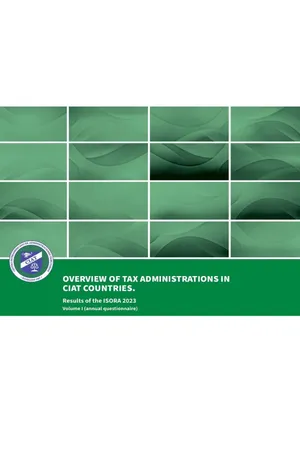
Overview of Tax Administrations in CIAT Countries:
Results of the ISORA 2023, Volume I (annual questionnaire)
- English
- ePUB (mobile friendly)
- Available on iOS & Android
Overview of Tax Administrations in CIAT Countries:
Results of the ISORA 2023, Volume I (annual questionnaire)
About this book
The current edition of the Overview of Tax Administrations in CIAT Countries (Volume I) has been prepared using data from the latest version of the International Survey on Revenue Administration (ISORA), collected for 179 countries in 2023 and reflecting the situation of tax administrations in 2022. The survey covers: 1) administered instruments, revenue collection, and budgets; 2) available human resources; 3) organization and operational functions (segmentation and registration of taxpayers, taxpayer assistance and services, filing and payment of obligations, enforced debt collection, and audit and tax control activities); and 4) innovative techniques and information and communication technologies (ICT) applied to tax administration and improving tax compliance.
Frequently asked questions
- Essential is ideal for learners and professionals who enjoy exploring a wide range of subjects. Access the Essential Library with 800,000+ trusted titles and best-sellers across business, personal growth, and the humanities. Includes unlimited reading time and Standard Read Aloud voice.
- Complete: Perfect for advanced learners and researchers needing full, unrestricted access. Unlock 1.4M+ books across hundreds of subjects, including academic and specialized titles. The Complete Plan also includes advanced features like Premium Read Aloud and Research Assistant.
Please note we cannot support devices running on iOS 13 and Android 7 or earlier. Learn more about using the app.
Information
Table of contents
- Cover
- Title Page
- Copyright Page
- Content
- Executive summary
- Introduction
- 1. The ISORA 2023 survey and CIAT countries in the international context of tax administrations
- 2. Administered revenue and financial resources
- 3. Characteristics of the employed staff
- 4. Organization and operational performance
- 5. Digital transformation and technological innovation
- 6. Final comments
- References